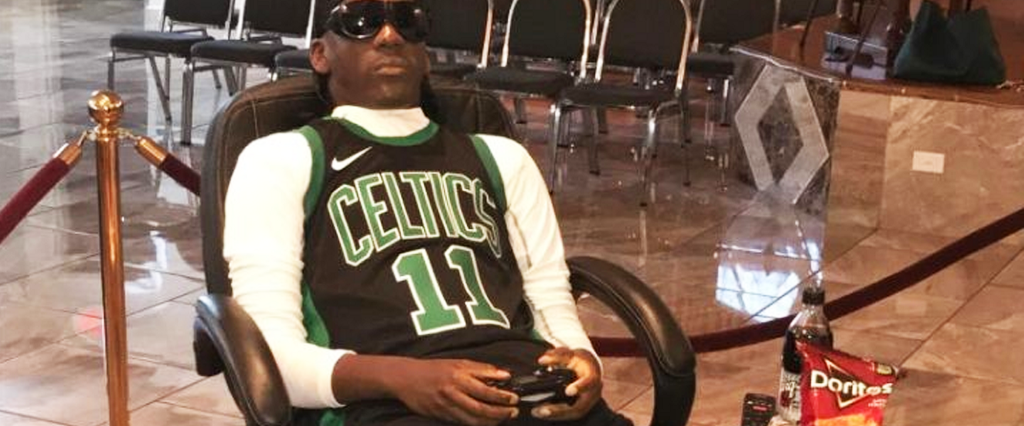The public viewing took place on the humid evening of July 8th in the New Orleans neighborhood of Tremé, inside a big house that had been converted into a mortuary. Renard Matthews was only 18 when he was robbed and killed while walking his dog a few blocks from his house. His cell phone was missing, and nobody could guess why he — “a nice young man,” as his neighbor put it — was left on the pavement with a bullet in his head.
Eventually, when the police cameras stopped flashing and the caution tape came down, his body was moved three miles to the embalming room at Charbonnet Labat Glapion Funeral Home. Friends and family would see Matthews for the last time at this Tremé house, his body posed in the most familiar way his mother could imagine: Leaning back in a leather office chair, dressed in Kyrie Irving’s Boston Celtics jersey, with shades on his face and a do-rag over his hair. His hands were placed around a PlayStation 4 controller, and within reach sat a bag of Nacho Cheese Doritos, a bottle of Barq’s root beer and a box of Chocolate Chip Crunch cereal.

Such unusual posing of a dead body predictably caught headlines around the country, but it was just the newest entry in a funeral tradition that’s been nicknamed “extreme embalming.” Instead of a body being dressed merely for an open casket, it’s instead posed in life-like dioramas that speak to the deceased’s personality or lifestyle.
Many Western cultures view the passing of a loved one with a morbid sort of regret that makes the thought of posing them in a “live” fashion deeply unsettling. As mortician and author Caleb Wilde notes on his blog, contemporary Americans are choosing cremation more than ever, with less “space” given to the dead in rest. “Even funerals are becoming less and less ingrained in our cultural ethos — for a reason I can’t entirely put my finger on — we’re slowly moving the dead out of the spaces of the living,” he writes. “Maybe we think it’s morbid to give the dead space? Maybe we’d just rather forget… or we think remembering is too painful? Maybe we think this ostracization is a part of closure?”
Extreme embalming in the U.S. is a niche industry among the usual closed caskets and cremations, but it’s only one of a number of extravagant funeral rituals observed around the world. Some cultures have no issue with keeping close to a corpse or posing it like it’s alive. Others choose to destroy the body, but in more visible and sustained ways than a simple cremation in a furnace.
Here is a sampling of the ways humans treat the dead, from the U.S. to Indonesia to Ghana and beyond.
The Capital of Extreme Embalming
Matthews was far from the first to be posed in a funeral home in Louisiana — in fact, New Orleans may be the U.S. capital for the tradition. In 2014, Charbonnet Funeral Home set up the body of Miriam Burbank, 53, as if she was at a house party, sitting under a spinning disco ball with a menthol cigarette in her hand and a can of Busch beer nearby. No detail was spared in the costuming, which included a manicure in the dark gold and black of the New Orleans Saints football team. “When I walked in, I feel like I was in her house and I didn’t hurt so much,” her sister Sherline Burbank said to a local reporter. “Because it’s more of her, and it’s like she’s not dead. It’s not like a funeral home. It’s like she’s just in the room with us.”
A number of black icons in New Orleans have gotten the diorama treatment, which is a testament to their importance given the challenges and expense of a posed embalming. The procedure takes special expertise and time to execute properly — more than four times the usual number of hours to complete, according to Wilde.
Jazz musician “Uncle” Lionel Batiste was dressed in a fine cream suit, bowler hat and sunglasses for his 2012 wake, which also featured his bass drum and Tremé Brass Band uniform next to him. New Orleans philanthropist and socialite Mickey Easterling, meanwhile, was posed in a relaxed lean in a wrought-iron chair, outfitted in a bold floral dress and a large lace hat. The stage for her 2014 wake featured a glass of Veuve Clicquot champagne and a pack of cigarettes. The stemware was Waterford crystal, while the “BITCH” pin on her lapel had diamonds. “My goal was to make her look even prettier than she was in real life,” friend Sammy Steele III told The Advocate, “because she was a larger-than-life person.”
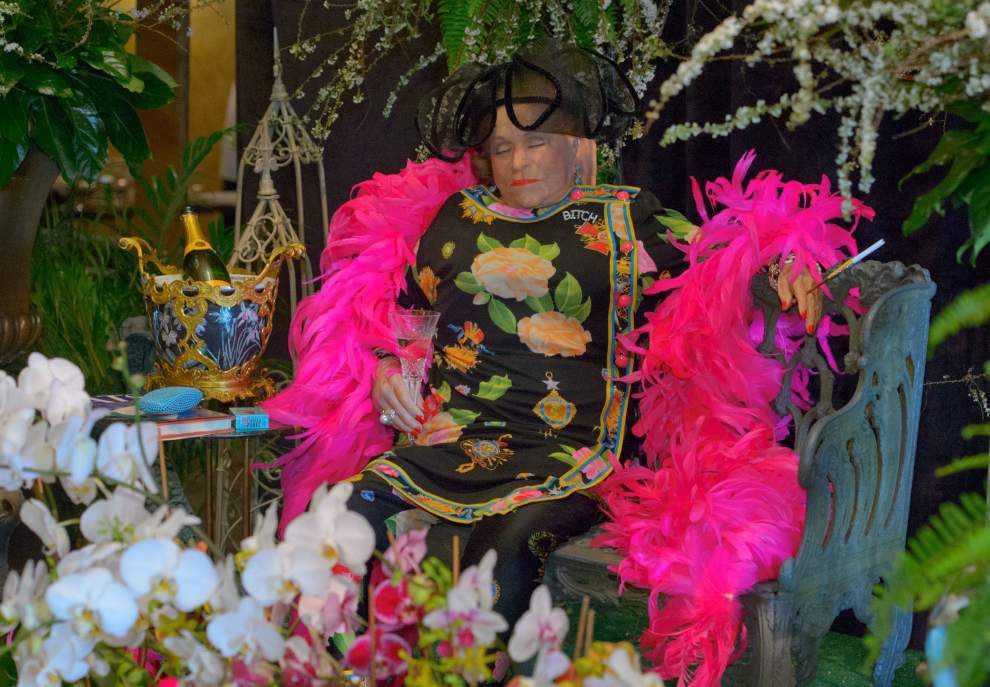
As it turns out, outside of the U.S., the innovator for these living-pose funerals is Puerto Rico, where Marin Funeral Home has made big business out of odd presentations. A 26-year-old man who was shot 15 times was embalmed to look alive and upright in a baseball cap and Polo shirt. Boxer Christopher Rivera was set up in a mini ring, standing with blue boxing gloves as if ready to fight on the ding of a bell. And one 22-year-old requested to be propped on top of his beloved Honda CBR600 motorcycle, decked out in full riding gear. Some funeral directors and local officials in Puerto Rico found these services distasteful and looked for criminal codes to restrict them, to no avail.
The nickname for the trend? El muerto parao, or “dead man standing.”
Living with the Dead in Indonesia
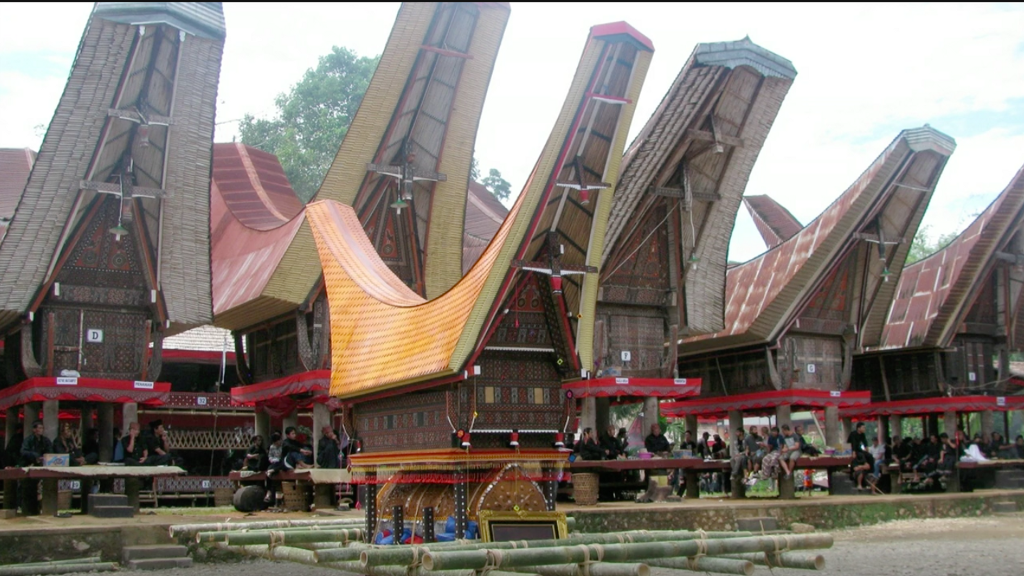
There are always large, curved-roof longhouses, almost shaped like aboveground boats, in the villages of Tana Toraja. The people of this small region in eastern Indonesia use those buildings, called Tongkonan, for the storage of their deceased loved ones. Despite being largely Christian, the residents of Tana Toraja have held onto one old animist tradition, in which the dead are viewed as being “sick” or “sleeping” until the time of their proper burial.
Funerals there are extravagant celebrations that involve the entire village, which means raising the funds to throw the event can take months and often years. During that time, the dead loved one “lives” in the Tongkonan, where they get daily visits from family and friends who change their clothes and leave them food to “eat.”
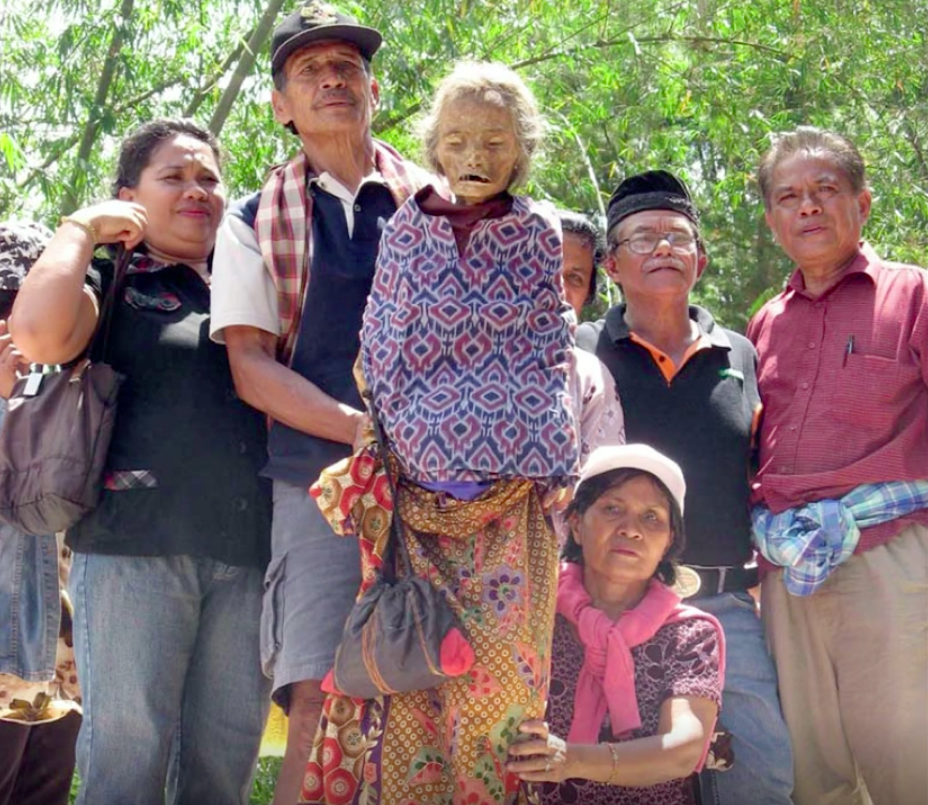
“I think Torajans socially recognize, and culturally express, what many of us feel to be true, despite the widespread expression of the biomedical definition of death. That is that our relationships with other humans, their impact on our social reality, doesn’t cease with the termination of the body. That’s why Torajans lavish love and attention on the most visible symbol of that relationship, the dead body,” anthropologist Kelli Swazey says in a TED Talk.
Tibet’s Sky ‘Burials’
A majority of Tibetans believe in Vajrayana Buddhism, in which a person’s spirit is believed to exist independent of the body, and therefore, moves out of a body (and into a new being) at the time of physical death.
Partly because of the hard-to-dig rocky soil in much of the Tibetan countryside, and partly because of the Buddhist mantra to be generous, believers dispose of dead loved ones in a pragmatic way.
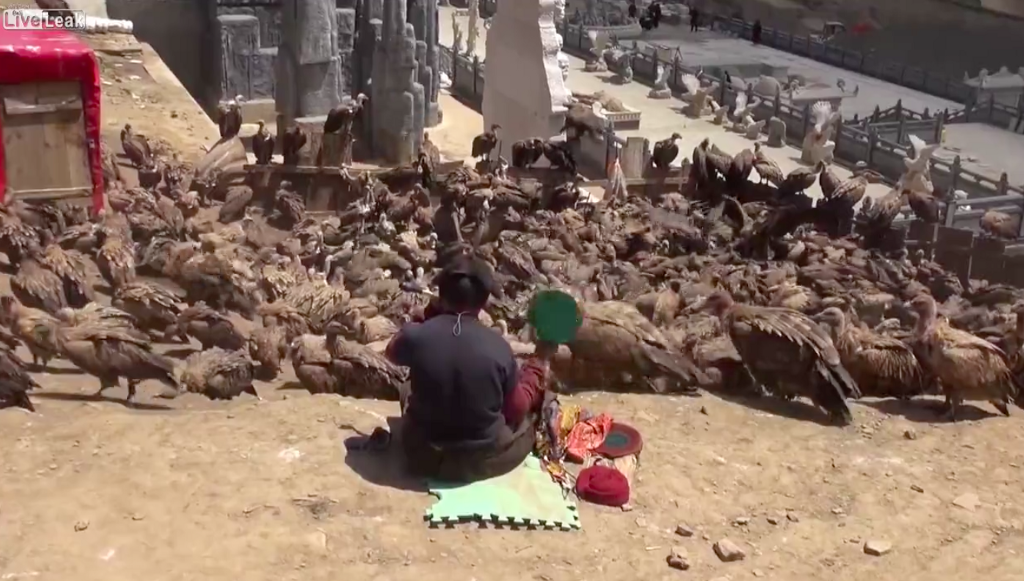
The fresh remains are given a religious ceremony with burning herbs and Buddhist chants before being taken away to a flat, rocky spot. That’s when a rogyapa, roughly translated as “body-breaker,” uses a large knife to tear open skin and cut away flesh to spread around the rock — a gruesome process that makes it easier for vultures to eat the flesh. In some villages, the remaining bones are pounded and mixed with yak butter for consumption by smaller birds like crows.
The lurid nature of sky burials have drawn tourism activity, mostly from Chinese nationals, which is by some accounts stressing the already tense relationship between Tibetans and the Chinese. There’s plenty of money to be made by bussing in tourists who want to video and photograph the burial, but some monks in particular have grown frustrated by the attitude of the visitors. “If a group of Tibetans were to surround a Chinese funeral and watch, laugh and take pictures, it wouldn’t be tolerated. It would be considered unethical according to party guidelines. One could even be taken to court,” one unnamed Tibetan monk says in a National Geographic clip.
“The tourists that come to Tibet nowadays are merely coming for the show,” says another monk. “It’s clear they are not able to understand the essence of the culture.”
Turning of the Bones
Deep in the central highlands of Madagascar, Malagasy elders prepare for a famadihana, an ancestral celebration that plays out like a massive party for villagers. Raucous dancing, drinking and food start the show, but things quiet down once the elders retreat to the graveyard and begin digging up the bones of their dead family members.
Buried in cloth, the bones are slowly revealed to the audience, triggering fanfare of voices and music. The personal touch is a splash of fine wine or expensive perfume, depending on what the deceased would’ve preferred.
The famadihana is a time to celebrate a family tree but also educate younger kids about the importance of the people who are gone. The “turning of the bones” is a show of respect and an acknowledgement that an ancestor’s influence lingers into the present; one ritual is to ask the remains for good fortune or favors. Even those who don’t believe the famadihana will literally grant them luck still buy into the tradition: “We do not believe we can communicate with the dead, but we do believe the famadihana strengthens our family between the generations,” Jean Jacques Ratovoherison, 30, told the New York Times.
Rocky Mountain High
The small town of Crestone sits in along the Sangre de Cristo mountain range in central Colorado, about three and a half hours south of Denver. There’s not too many people who live here — the population was just 127 in the 2010 Census — but it’s home to a very special final destination for the dead.
The Crestone End-of-Life Project is a project of the nonprofit Informed Final Choices, which advocates for end-of-life care and reform in the U.S. Its facility in Crestone is one of the only locations in the country permitted for public open-air cremation, better described as a funeral pyre. A ring-shaped fence made of bamboo surrounds the pyre site, where friends and family arrive to arrange logs of pine and spruce around the body. Resin-rich juniper boughs are also traditionally layered on the body, to aid in burning and scent the smoke with an herbal musk.
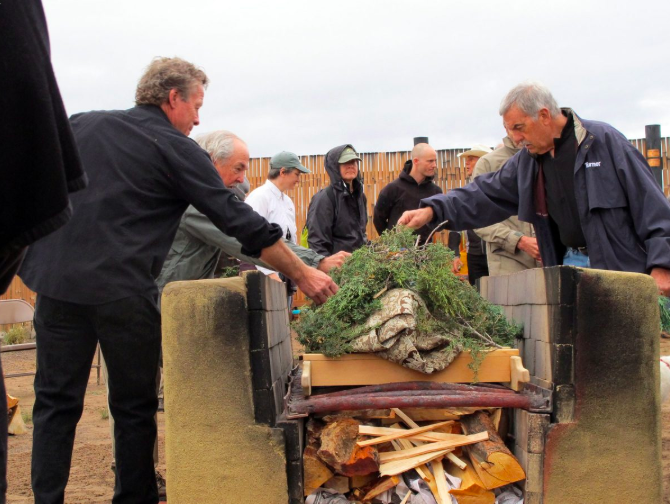
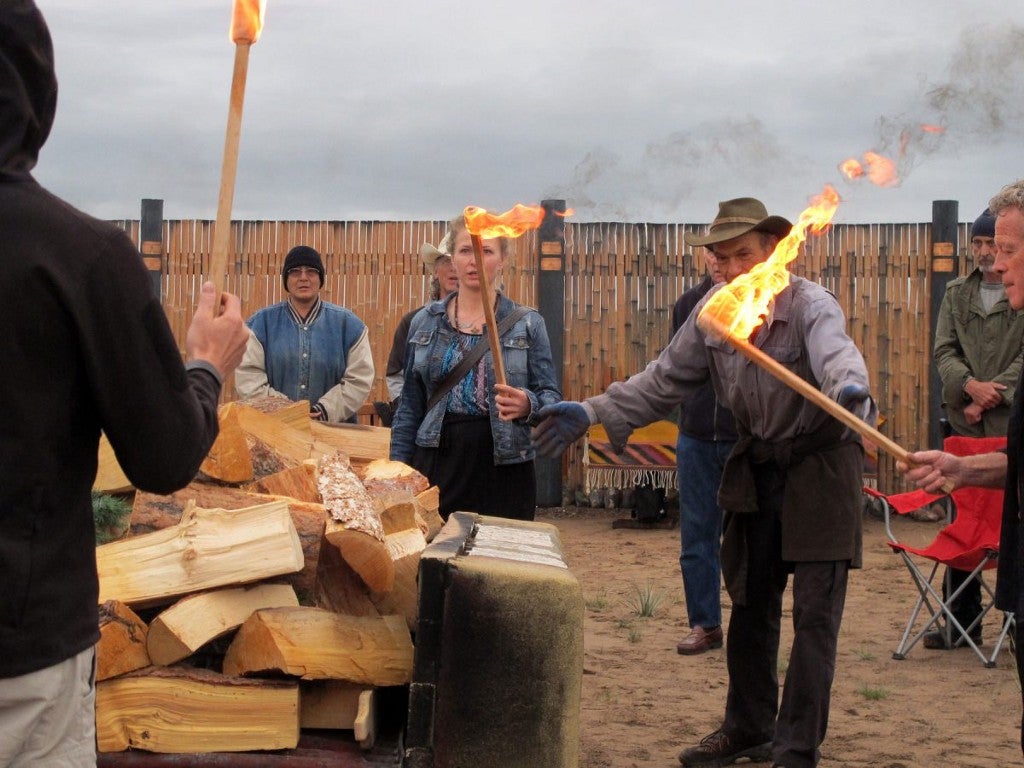
As writer Caitlin Doughty observed at one cremation for a young woman named “Laura”: “A signal was given, and they came together to set Laura aflame, just as the sun peered above the horizon. As her body caught fire, white smoke swirled about in tiny cyclones, twisting upward and disappearing into morning sky. … After a few minutes the whirlwinds dispersed, and glowing red flames danced in their place. The fire gathered strength, shooting up six feet high.”
Human societies have long craved closure around death, and whether through ancient rituals or modern twists on classic funeral rites, people continue to search for the best methods to grant the dead some peace. Exactly how far someone should go to ensure that peace is apparently only limited by our imaginations.
